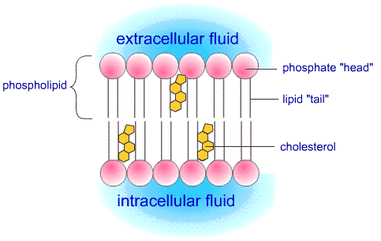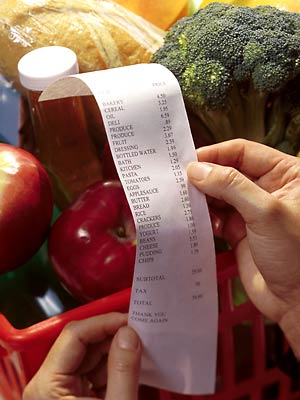For the past few decades we’ve all been bombarded with health professionals telling us that fats are bad and that the fats in our food are responsible for making us fat. However, we’re learning that not only are fats healthy, and essential for our bodies to grow, heal and function properly, eating the right fats can help to boost our metabolisms and ward off the extra pounds.
Having fat in your diet is not making you fat, its eating too much and the wrong types of fat that’s the problem. Not all fats are created equal. However, most North Americans tend to eat the wrong types of fats and too much of them.
Fats are essential to our well being as they are one of the body’s basic building blocks. Every single cell in our body requires fat, and yes even cholesterol (a type of fat), to produce and maintain our cell walls among other things. The quality of fat that we consume affects the quality of our cell structure.
Below is a simple picture of a cell wall showing the fats (lipid tail) and the cholesterol and how they are integrated into our cell walls.
Having fat in your diet is not making you fat, its eating too much and the wrong types of fat that’s the problem. Not all fats are created equal. However, most North Americans tend to eat the wrong types of fats and too much of them.
Fats are essential to our well being as they are one of the body’s basic building blocks. Every single cell in our body requires fat, and yes even cholesterol (a type of fat), to produce and maintain our cell walls among other things. The quality of fat that we consume affects the quality of our cell structure.
Below is a simple picture of a cell wall showing the fats (lipid tail) and the cholesterol and how they are integrated into our cell walls.
Our need for healthy fats comes from the fact that we can produce most kinds within our body, but not the omega 3 and omega 6 fatty acids, which is why they are called essential fatty acids.
So how do we know if we aren’t getting enough of the fats that our bodies require? Well the body, in its infinite wisdom, likes to send us some signals that we need more fats, and more healthy fats. Some of the more common signs are:
While these can also have other causes, not just a deficiency in healthy fats, it is a good idea to consider your intake of fatty acids when your body is sending you these messages.
So how do I know which fats to eat and which to avoid?
Many processed and packaged foods are made with poor quality fats, usually refined omega 6 fats, animal based saturated fats and trans fats. The source for these fats include refined and processed vegetable oils which are not only abundant, but also very cheap. Adding fat to processed foods is not only cheap, it also improves the taste and the texture. The body then uses these poor quality fats to build the cell walls, and like anything, when you use poor building materials, the result reflects this poor quality. This results in cells that have walls that are more rigid and stiff, and less able to communicate or be flexible. The cell then has reduced function and increased susceptibility to inflammatory processes. Fats like cottonseed, soy and corn oil are common in many ingredient lists and are a source of poor quality fats.
So what would be a ‘high quality’ cell wall building material? The healthy omega 3 fats are a great place to start! These higher quality fats translate into cells that are more flexible and quicker to respond to intercellular signals. The healthy fats also allow the body to produce certain prostaglandins (a hormone like substance the body uses as a signal for many different functions) that can reduce inflammation and pain among other things. Omega 3’s are commonly found in cold water fish like wild salmon, herring, sardines and mackeral (best to stick with the smaller fishes to reduce the amount of toxins), flax, chia and hemp seeds, walnuts, brazil nuts and sea veggies.
While we need both the omega 3 and 6 fatty acids, the amounts that we get from our food has been heavily skewed to the omega 6 side in recent years as a result of the refining of oils and the increased amount of processed foods we consume. Hunter-gatherer humans ate high quality omega 6 from various nuts and seeds, and to a lesser amount than we now receive from food. The ratio between the amount of omega 3 and 6 that comprise our cell walls is an important indicator of cellular health, susceptibility to various diseases and the how prone we are to inflammation. The importance of knowing this ratio is that when we have too much omega 6 in relation to our omega 3 content, our body is more prone to inflammation and associated chronic illnesses such as cardiovascular disease and cancer. This ratio, along with other information on the amount of various lipids (fats) in your body and their size gives you a quantifiable number to improve upon and monitor.
Although it’s true that all parts of our bodies require fats, there are a few areas that are especially impacted by our levels and compositions of fats. The brain, for instance, is made up of about 50-60% fat, and mostly the omega 3 fat called DHA (some other omega 3 fats are EPA and ALA). In order to function properly, and produce a happy, healthy and intellegent brain, we need adequate amounts of healthy fats. Omega 3 deficiencies, or disturbances in its metabolism in the brain, have been linked to many issues including depression, anxiety, bipolar disorder, schizophrenia and attention issues.
The heart and cardiovascular system also rely on healthy fats. Likely you’ve heard of the heart healthy benefits of omega 3’s and other healthy fats such as olive oil (omega 9 monosaturated fat). They work to reduce the bad fats (LDL, Triglycerides) and work to increase our healthy fats (HDL), all while decreasing inflammation. Recently, what has also been shown is that healthy omega 3 fats help to reduce the more dangerous forms of the bad fats which are the smaller and more dense LDL particles as opposed to the bigger, more fluffy LDL particles.
And what about all the buzz on how eating more high quality fats can actually help you lose weight!? Well this is due in part to the fact that healthy, flexible cell walls (made from high quality fats), are better able to metabolize and interact with insulin. Healthier cells result in healthier blood sugar metabolism. Integrating healthy fats into your diet also decreases inflammation and helps increase satiety.
So how do you know where your cholesterol and fat levels are at? What about the size of fat particles or the omega 3:6 ratio?
The answer to that is that there are various ways to go about this. Your MD can easily order a lipid panel (generally includes LDL, HDL, triglyceride, total cholesterol and a ratio of your total cholesterol:HDL levels) and you can request that your MD also order a test to check the particle size of your LDL and to check for a particle called apolipoprotein a. While your ND can also order these tests (in most provinces and states), they may not be covered by your health care insurance (government or private). To determine the difference in your ratio between Omega 3 and 6 fatty acids, there is a simple test that naturopathic doctors and MD’s can order. This can then be tracked and used as a quanititative measure for your treatment protocols. A variety of other tests exist to determine the amount and quality of essential fatty acid levels.
Of course, omega 3 and 6 fats are just one part of the picture. They are considered a PUFA (polyunsaturated fatty acid), and there are many other forms that play a role in a healthy body including MUFA’s (monounsaturated fatty acids), certain plant sterols, saturated fatty acids (such as from coconut oil), and medium chain fatty acids. Education and awareness about what we put into our bodies is vital. A balanced and whole foods diet is a great place to start in providing your body with the tools it needs to grow, heal and flourish!
So how do we know if we aren’t getting enough of the fats that our bodies require? Well the body, in its infinite wisdom, likes to send us some signals that we need more fats, and more healthy fats. Some of the more common signs are:
- Dry, itchy, flaking and scaly skin
- Hard and/or impacted ear wax
- High cholesterol levels
- Depression and other mental health concerns
- Soft, brittle or cracked nails
- Memory problems
- Attention deficit problems
- Dry eyes
- Dry, brittle hair
While these can also have other causes, not just a deficiency in healthy fats, it is a good idea to consider your intake of fatty acids when your body is sending you these messages.
So how do I know which fats to eat and which to avoid?
Many processed and packaged foods are made with poor quality fats, usually refined omega 6 fats, animal based saturated fats and trans fats. The source for these fats include refined and processed vegetable oils which are not only abundant, but also very cheap. Adding fat to processed foods is not only cheap, it also improves the taste and the texture. The body then uses these poor quality fats to build the cell walls, and like anything, when you use poor building materials, the result reflects this poor quality. This results in cells that have walls that are more rigid and stiff, and less able to communicate or be flexible. The cell then has reduced function and increased susceptibility to inflammatory processes. Fats like cottonseed, soy and corn oil are common in many ingredient lists and are a source of poor quality fats.
So what would be a ‘high quality’ cell wall building material? The healthy omega 3 fats are a great place to start! These higher quality fats translate into cells that are more flexible and quicker to respond to intercellular signals. The healthy fats also allow the body to produce certain prostaglandins (a hormone like substance the body uses as a signal for many different functions) that can reduce inflammation and pain among other things. Omega 3’s are commonly found in cold water fish like wild salmon, herring, sardines and mackeral (best to stick with the smaller fishes to reduce the amount of toxins), flax, chia and hemp seeds, walnuts, brazil nuts and sea veggies.
While we need both the omega 3 and 6 fatty acids, the amounts that we get from our food has been heavily skewed to the omega 6 side in recent years as a result of the refining of oils and the increased amount of processed foods we consume. Hunter-gatherer humans ate high quality omega 6 from various nuts and seeds, and to a lesser amount than we now receive from food. The ratio between the amount of omega 3 and 6 that comprise our cell walls is an important indicator of cellular health, susceptibility to various diseases and the how prone we are to inflammation. The importance of knowing this ratio is that when we have too much omega 6 in relation to our omega 3 content, our body is more prone to inflammation and associated chronic illnesses such as cardiovascular disease and cancer. This ratio, along with other information on the amount of various lipids (fats) in your body and their size gives you a quantifiable number to improve upon and monitor.
Although it’s true that all parts of our bodies require fats, there are a few areas that are especially impacted by our levels and compositions of fats. The brain, for instance, is made up of about 50-60% fat, and mostly the omega 3 fat called DHA (some other omega 3 fats are EPA and ALA). In order to function properly, and produce a happy, healthy and intellegent brain, we need adequate amounts of healthy fats. Omega 3 deficiencies, or disturbances in its metabolism in the brain, have been linked to many issues including depression, anxiety, bipolar disorder, schizophrenia and attention issues.
The heart and cardiovascular system also rely on healthy fats. Likely you’ve heard of the heart healthy benefits of omega 3’s and other healthy fats such as olive oil (omega 9 monosaturated fat). They work to reduce the bad fats (LDL, Triglycerides) and work to increase our healthy fats (HDL), all while decreasing inflammation. Recently, what has also been shown is that healthy omega 3 fats help to reduce the more dangerous forms of the bad fats which are the smaller and more dense LDL particles as opposed to the bigger, more fluffy LDL particles.
And what about all the buzz on how eating more high quality fats can actually help you lose weight!? Well this is due in part to the fact that healthy, flexible cell walls (made from high quality fats), are better able to metabolize and interact with insulin. Healthier cells result in healthier blood sugar metabolism. Integrating healthy fats into your diet also decreases inflammation and helps increase satiety.
So how do you know where your cholesterol and fat levels are at? What about the size of fat particles or the omega 3:6 ratio?
The answer to that is that there are various ways to go about this. Your MD can easily order a lipid panel (generally includes LDL, HDL, triglyceride, total cholesterol and a ratio of your total cholesterol:HDL levels) and you can request that your MD also order a test to check the particle size of your LDL and to check for a particle called apolipoprotein a. While your ND can also order these tests (in most provinces and states), they may not be covered by your health care insurance (government or private). To determine the difference in your ratio between Omega 3 and 6 fatty acids, there is a simple test that naturopathic doctors and MD’s can order. This can then be tracked and used as a quanititative measure for your treatment protocols. A variety of other tests exist to determine the amount and quality of essential fatty acid levels.
Of course, omega 3 and 6 fats are just one part of the picture. They are considered a PUFA (polyunsaturated fatty acid), and there are many other forms that play a role in a healthy body including MUFA’s (monounsaturated fatty acids), certain plant sterols, saturated fatty acids (such as from coconut oil), and medium chain fatty acids. Education and awareness about what we put into our bodies is vital. A balanced and whole foods diet is a great place to start in providing your body with the tools it needs to grow, heal and flourish!



 RSS Feed
RSS Feed
